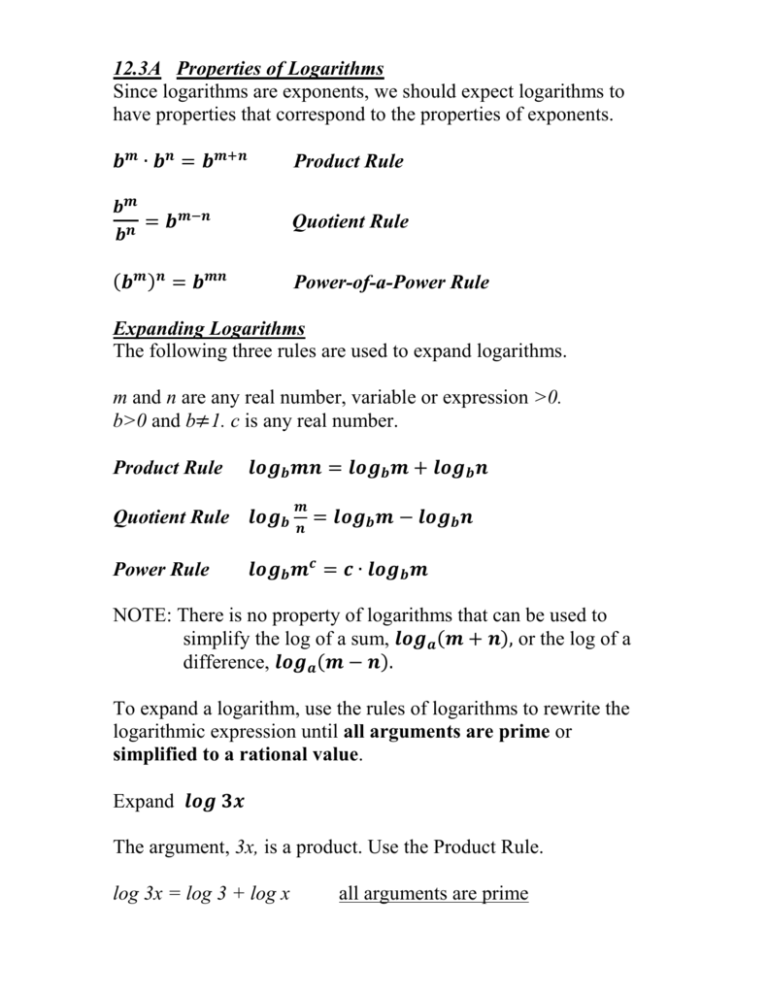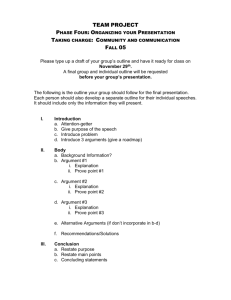Section 12.3a
advertisement

12.3A Properties of Logarithms Since logarithms are exponents, we should expect logarithms to have properties that correspond to the properties of exponents. 𝒃𝒎 ∙ 𝒃𝒏 = 𝒃𝒎+𝒏 𝒃𝒎 𝒃𝒏 Product Rule = 𝒃𝒎−𝒏 Quotient Rule (𝒃𝒎 )𝒏 = 𝒃𝒎𝒏 Power-of-a-Power Rule Expanding Logarithms The following three rules are used to expand logarithms. m and n are any real number, variable or expression >0. b>0 and b≠1. c is any real number. Product Rule 𝒍𝒐𝒈𝒃 𝒎𝒏 = 𝒍𝒐𝒈𝒃 𝒎 + 𝒍𝒐𝒈𝒃 𝒏 Quotient Rule 𝒍𝒐𝒈𝒃 Power Rule 𝒎 𝒏 = 𝒍𝒐𝒈𝒃 𝒎 − 𝒍𝒐𝒈𝒃 𝒏 𝒍𝒐𝒈𝒃 𝒎𝒄 = 𝒄 ∙ 𝒍𝒐𝒈𝒃 𝒎 NOTE: There is no property of logarithms that can be used to simplify the log of a sum, 𝒍𝒐𝒈𝒂 (𝒎 + 𝒏), or the log of a difference, 𝒍𝒐𝒈𝒂 (𝒎 − 𝒏). To expand a logarithm, use the rules of logarithms to rewrite the logarithmic expression until all arguments are prime or simplified to a rational value. Expand 𝒍𝒐𝒈 𝟑𝒙 The argument, 3x, is a product. Use the Product Rule. log 3x = log 3 + log x all arguments are prime Expand 𝒍𝒐𝒈𝟓 𝟔 The argument, 6, is not prime. Write it as a product of primes, 𝟔 = 𝟐 ∙ 𝟑. Use the Product Rule. 𝒍𝒐𝒈𝟓 𝟔 = 𝒍𝒐𝒈𝟓 (𝟐 ∙ 𝟑) = 𝒍𝒐𝒈𝟓 𝟐 + 𝒍𝒐𝒈𝟓 𝟑 -------------------------------------------------------------------------------Expand 𝒍𝒐𝒈 𝟏𝟎𝒙 The argument, 𝟏𝟎𝒙, is a product. Although 10 is not prime, we do not factor it because the log is base–10. Use the Product Rule. 𝒍𝒐𝒈 𝟏𝟎𝒙 = 𝒍𝒐𝒈 𝟏𝟎 + 𝒍𝒐𝒈 𝒙 = 𝟏 + 𝒍𝒐𝒈 𝒙 -------------------------------------------------------------------------------Expand 𝒍𝒐𝒈𝟓 𝟒𝟗 The argument, 49, is not prime. Write it as a power, 𝟒𝟗 = 𝟕𝟐 . Use the Power Rule. 𝒍𝒐𝒈𝟓 𝟒𝟗 = 𝒍𝒐𝒈𝟓 𝟕𝟐 = 𝟐 ∙ 𝒍𝒐𝒈𝟓 𝟕 the argument, 7, is prime -------------------------------------------------------------------------------𝒙 Expand 𝒍𝒐𝒈𝟐 𝟑 𝒙 The argument, , is a quotient. Use the Quotient Rule. 𝟑 𝒙 𝒍𝒐𝒈𝟐 = 𝒍𝒐𝒈𝟐 𝒙 − 𝒍𝒐𝒈𝟐 𝟑 all arguments are prime 𝟑 -------------------------------------------------------------------------------Expand 𝒍𝒐𝒈𝟕 𝒙𝟑 The argument, 𝒙𝟑 , is a power. Use the Power Rule. 𝒍𝒐𝒈𝟕 𝒙𝟑 = 𝟑 ∙ 𝒍𝒐𝒈𝟕 𝒙 the argument, x, is prime If more than one rule must be applied, use the reverse order of operations to expand the logarithm. Expand 𝒍𝒐𝒈𝟑 𝟓𝒂𝟒 The argument, 𝟓𝒂𝟒 , contains a product and a power. To simplify 𝟓𝒂𝟒 we would (1) do the power (2) do the product To expand, use the Product Rule then the Power Rule. 𝒍𝒐𝒈𝟑 𝟓𝒂𝟒 = 𝒍𝒐𝒈𝟑 𝟓 + 𝒍𝒐𝒈𝟑 𝒂𝟒 = 𝒍𝒐𝒈𝟑 𝟓 + 𝟒 ∙ 𝒍𝒐𝒈𝟑 𝒂 all arguments are prime -------------------------------------------------------------------------------Expand 𝒍𝒐𝒈𝟑 (𝟓𝒂)𝟒 The argument, (𝟓𝒂)𝟒 , contains a product and a power. To simplify (𝟓𝒂)𝟒 we would (1) do the product (2) do the power To expand, use the Power Rule then the Product Rule. 𝒍𝒐𝒈𝟑 (𝟓𝒂)𝟒 = 𝟒 ∙ 𝒍𝒐𝒈𝟑 𝟓𝒂 = 𝟒(𝒍𝒐𝒈𝟑 𝟓 + 𝒍𝒐𝒈𝟑 𝒂) = 𝟒 ∙ 𝒍𝒐𝒈𝟑 𝟓 + 𝟒 ∙ 𝒍𝒐𝒈𝟑 𝒂 all arguments are prime -------------------------------------------------------------------------------Expand 𝒍𝒐𝒈𝟑 √𝟑𝒙 𝟏⁄ 𝟐, The argument, √𝟑𝒙 = (𝟑𝒙) contains a product and a power. 𝟏⁄ 𝟐 To simplify (𝟑𝒙) we would (1) do the product (2) do the power To expand, use the Power Rule then the Product Rule. 𝟏⁄ 𝟐 𝒍𝒐𝒈𝟑 √𝟑𝒙 = 𝒍𝒐𝒈𝟑 (𝟑𝒙) 𝟏 𝟏 𝟐 𝟐 = ∙ 𝒍𝒐𝒈𝟑 𝟑𝒙 = (𝒍𝒐𝒈𝟑 𝟑 + 𝒍𝒐𝒈𝟑 𝒙) = 𝟏 𝟏 𝟏 𝟏 ∙ 𝒍𝒐𝒈𝟑 𝟑 + ∙ 𝒍𝒐𝒈𝟑 𝒙 = + ∙ 𝒍𝒐𝒈𝟑 𝒙 the argument, x, is 𝟐 𝟐 𝟐 𝟐 prime See Examples 1 – 4 on pages 845 – 848. -------------------------------------------------------------------------------Proofs of the Logarithm Properties Product Rule 𝒍𝒐𝒈𝒃 𝒎𝒏 = 𝒍𝒐𝒈𝒃 𝒎 + 𝒍𝒐𝒈𝒃 𝒏 m is a power of a, say 𝒎 = 𝒃𝒙 → 𝒙 = 𝒍𝒐𝒈𝒃 𝒎 n is a power of a, say 𝒏 = 𝒃𝒚 → 𝒚 = 𝒍𝒐𝒈𝒃 𝒏 𝒍𝒐𝒈𝒃 𝒎𝒏 = 𝒍𝒐𝒈𝒃 𝒃𝒙 𝒃𝒚 = 𝒍𝒐𝒈𝒃 𝒃𝒙+𝒚 = 𝒙 + 𝒚 = 𝒍𝒐𝒈𝒃 𝒎 + 𝒍𝒐𝒈𝒃 𝒏 -------------------------------------------------------------------------------Quotient Rule 𝒍𝒐𝒈𝒃 𝒎 𝒏 = 𝒍𝒐𝒈𝒃 𝒎 − 𝒍𝒐𝒈𝒃 𝒏 m is a power of a, say 𝒎 = 𝒃𝒙 → 𝒙 = 𝒍𝒐𝒈𝒃 𝒎 n is a power of a, say 𝒏 = 𝒃𝒚 → 𝒚 = 𝒍𝒐𝒈𝒃 𝒏 𝒍𝒐𝒈𝒃 𝒎 𝒏 = 𝒍𝒐𝒈𝒃 𝒃𝒙 𝒃𝒚 = 𝒍𝒐𝒈𝒃 𝒃𝒙−𝒚 = 𝒙 − 𝒚 = 𝒍𝒐𝒈𝒃 𝒎 − 𝒍𝒐𝒈𝒃 𝒏 -------------------------------------------------------------------------------Power Rule 𝒍𝒐𝒈𝒃 𝒎𝒄 = 𝒄 ∙ 𝒍𝒐𝒈𝒃 𝒎 m is a power of a, say 𝒎 = 𝒃𝒙 → 𝒙 = 𝒍𝒐𝒈𝒃 𝒎 𝒍𝒐𝒈𝒃 𝒎𝒄 = 𝒍𝒐𝒈𝒃 (𝒃𝒙 )𝒄 = 𝒍𝒐𝒈𝒃 𝒃𝒄𝒙 = 𝒄𝒙 = 𝒄 ∙ 𝒍𝒐𝒈𝒃 𝒎








